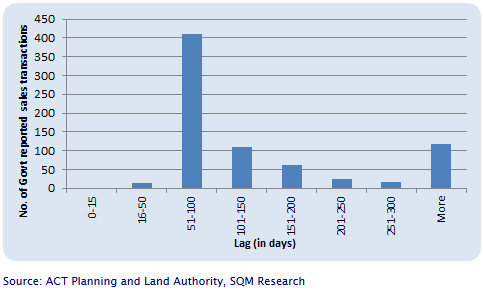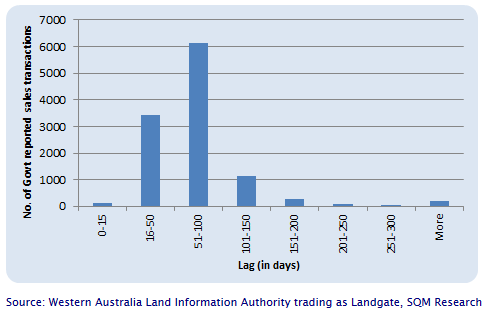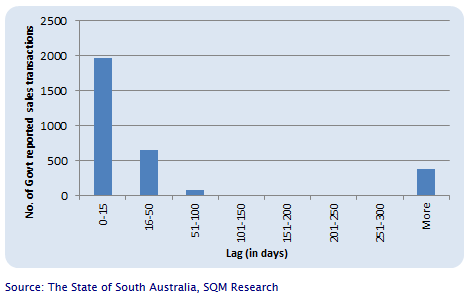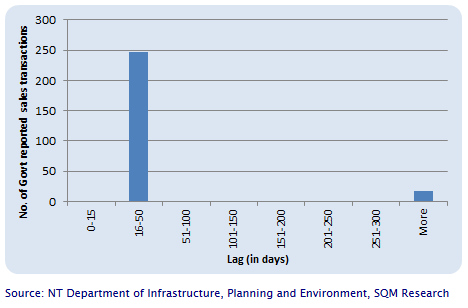
From SQM Research’s Weekly Newsletter comes the sequel to last week’s report questioning the validity of the RP Data-Rismark daily home values index.
Following on from last week’s report, please find below the second part to this segment on data lag times and their effect upon readings for the various house price reporters.
Lets start this week with ACT:

For the ACT, of the 756 sales records sent through during the month of May, the average lag time was 212 days, meaning that half the records sent throughout May actually represented sales that happened six months prior or even earlier. No sales records were reported through within 15 days of the exchange date.
Once again this is an appalling situation and may go some way to explain why RP data reported a boom (3.8% rise) in house prices for the March quarter, whereas at the same time, vendors were slashing each other’s throats – with asking prices falling by 3.8% for the same period, aswell as other data reporters recorded flat to falling house prices over the same time.
Remember, RP Data grab sales that occur from previous time periods to work out a present day index price which never gets revised. In contrast, other property data reporters (rightfully) just report on sales which occurred for the period reported on and revise their previous periodical results with data that has come through since that time.
Now Western Australia:

For Western Australia, things are a little bit better. The average lag is 113 days based on based on 11,422 residential property records sent through for the Month of May. There were however, just 109 sales that were sent through within 15 days of the contract date. And of course, none were sent through on the day itself.
South Australia:

South Australia is better still with an average lag time of just 59 days. That was based on 3,113 records sent for May. What is impressive is that there were 1,968 properties reported within 15 days of the property exchanging contracts. Funnily enough this has always been the state where the various data reporters have consistently had the highest correlation between each other with regard to the movement in house prices. That is because the data, unlike most other states, is accurate and timely. Note there are still no properties being sent through on the same day as they sold.
Northern Territory:

Then finally, the Northern Territory where the lag time is better still at 38 days based on 266 properties sent through for the month.
So there you have it. In none of the states is there a situation where any sales are coming through on the same day as they sold, rather it is taking a number of months to come through. In nearly all states, there are a number of records that are literally taking over a year to get through, which generally represent newly constructed dwellings.
We received a lot of public interest last week on this issue and I see some have argued back in some forums that so long as the daily index is consistent then its okay.
But hang on, its’ not Okay.
Besides the moral issue of misleading people, if the daily readings of this index really represent a mix of sales that actually transacted months or even years back, then it is most likely the index will not be able to capture current turning points in the market, which it was supposedly designed to do.
Instead, all it will capture each day are just spasms of various historical market movements mixed in with the current market. No wonder the index recorded rises in Melbourne house prices in early 2012. It was still capturing and reporting on the last of the market upturn in 2010!
And no wonder the index best matches the ABS data when you lag it by a quarter. E.g the RP Data June quarter results from its daily index best match the March Quarter results from the ABS. Yes that’s right folks, this thing is behind the ABS house price series, not in front.
So for the June quarter, RP Data yesterday recorded a very soft 0.1% increase in house prices for the 8 capital city average. Noted of course they did not run with this number in their headline.
Nevertheless, this was precisely the same soft result for the ABS’s preliminary March Quarter Results.
In the March 2013 Quarter, RP Data recorded a strong 2.9% increase for houses. The ABS also reported a rather strong 1.6% rise for the December 2012 Quarter on their preliminary results.
In the December 2012 Quarter, RP Data registered a weak housing market with a 1.1% decline for houses in the Quarter. Meanwhile for the September quarter the ABS Registered a rather benign rise of 0.3%
And so it goes on. RP’s September Quarter result was a strong 2.2% while the ABS recorded a 0.5% increase for the June Quarter. Take the net result of those last two readings and you get a net increase of 1.1% increase from RP Data and a 0.8% increase from ABS. Except of course that RP Data lag the results by a quarter.
The group reported a 1.4% decline for houses in the June Quarter 2012. ABS had a 1.1% decline for the March Quarter 2012.
In each and every quarter, the fit between the ABS and RP data is almost perfect when you presume that RP Data are really reporting for the quarter prior to the one they are actually publishing. So this makes the preliminary ABS house price series a good predictor of the RP Data house price results and the RP data results a good predictor of…nothing. Or at best, just confirmation of what we already knew via the ABS a quarter ago.
So here is my prediction: Assuming this woeful index is still around next quarter, I predict that whatever the ABS comes out with for the June quarter, that RP’s September quarter result will closely match it!

